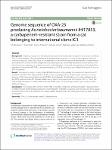Genome sequence of OXA-23 producing Acinetobacter baumannii IHIT7853, a carbapenem-resistant strain from a cat belonging to international clone IC1
Ewers, Christa
Klotz, Peter
Scheufen, Sandra
Leidner, Ursula
Göttig, Stephan
Semmler, Torsten
Background: Multidrug resistance in Acinetobacter baumannii has dramatically increased in recent years worldwide. Thus, last-line antibiotics like carbapenems are increasingly being used which in turn further augments selection pressure for resistant strains. Resistance to carbapenems in A. baumannii is frequently mediated by carbapenemases, particularly OXA-23 and OXA-58. Carbapenemase-producing bacteria are mainly described in human patients and the intestinal tract represents a common source for such pathogens. In this study, we sequenced and analyzed the genome of A. baumannii IHIT7853, a carbapenem-resistant, OXA-23 producing strain isolated from cystitis in a cat in 2000 in Germany. Results: Phylogenetic analysis revealed that IHIT7853 belonged to the globally distributed international clone IC1 and MLST type ST1/ST231 (Pasteur/Oxford MLST scheme). A phylogenetic tree based on the maximum common genome of 18 A. baumannii isolates placed IHIT7853 close to human clinical isolates, such as the multidrug-resistant (MDR) outbreak strain AYE that was isolated from a patient with pneumonia and cystitis in 2001 in France. The OXA-23 plasmid sequence could be determined as 53,995 bp in size, possessing resistance genes strA and strB in addition to bla OXA-23. Conclusions: The analysis of the genome of IHIT7853 reveals that companion animals carry MDR A. baumannii that resemble relevant clonal lineages involved in severe infections in humans. As urinary tract infections are often caused by bacteria that reside in the intestinal tract, future studies should unveil, if the animal gut serves as a source for MDR A. baumannii.
Dateien zu dieser Publikation
Keine Lizenzangabe

